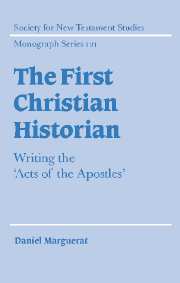Book contents
- Frontmatter
- Contents
- Preface
- 1 How Luke wrote history
- 2 A narrative of beginnings
- 3 The unity of Luke–Acts: the task of reading
- 4 A Christianity between Jerusalem and Rome
- 5 The God of Acts
- 6 The work of the Spirit
- 7 Jews and Christians in conflict
- 8 Ananias and Sapphira (Acts 5. 1–11): the original sin
- 9 Saul's conversion (Acts 9; 22; 26)
- 10 The enigma of the end of Acts (28. 16–31)
- 11 Travels and travellers
- Bibliography
- Index of passages
4 - A Christianity between Jerusalem and Rome
Published online by Cambridge University Press: 22 September 2009
- Frontmatter
- Contents
- Preface
- 1 How Luke wrote history
- 2 A narrative of beginnings
- 3 The unity of Luke–Acts: the task of reading
- 4 A Christianity between Jerusalem and Rome
- 5 The God of Acts
- 6 The work of the Spirit
- 7 Jews and Christians in conflict
- 8 Ananias and Sapphira (Acts 5. 1–11): the original sin
- 9 Saul's conversion (Acts 9; 22; 26)
- 10 The enigma of the end of Acts (28. 16–31)
- 11 Travels and travellers
- Bibliography
- Index of passages
Summary
Luke's writing leads its reader on a geographical axis from Jerusalem, where the Infancy narratives unfold (Luke 1–2), to Rome, where Paul arrives as a prisoner (Acts 28). Narratively, Luke's plot links together Jerusalem and Rome. No one denies the theological dimension of this geography, yet questions remain. How does Luke theologically link these two great cultural and religious centres? How does he situate Christianity between Jerusalem and Rome – or, alternatively, between Israel and the Roman Empire?
Without exaggeration, one could say that the whole history of the interpretation of Luke–Acts unfolds from this problematic. Anyone who wants to establish the theological aim of Luke's writing must first determine how the author positions Christianity in relation to Judaism and in relation to the pagan world.
In my opinion, research has constantly held the relationship between Jerusalem and Rome in a positive/negative polarity. Adopting Rome would require Luke to break with Jerusalem. Alternatively, those who think he maintains an openness to Judaism assume that this position requires him to distance himself from Empire. A few examples are in order. Alfred Loisy, in his monumental commentary of 1920, defended the idea of a redaction of Acts in several stages. In the end, Israel, victim of a textual revision aimed at valorizing the image of Rome, is depicted as the quintessence of evil. Ernst Haenchen also correlates the rejection of Jerusalem and an opening toward the pagans.
- Type
- Chapter
- Information
- The First Christian HistorianWriting the 'Acts of the Apostles', pp. 65 - 84Publisher: Cambridge University PressPrint publication year: 2002
- 1
- Cited by



